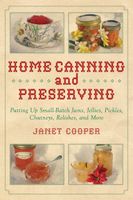Advertisement
Jelly: The Boiled Method
Appears in
By Janet Cooper
Published 2014
Jellies made by this method are a bit tricky. It is easy for them to end up either slightly rubbery or else runny. So be sure to test for jelling and be prepared for some interesting ice cream toppings along the way, but the results of a well-jelled jelly are most yummy and worth the effort. The yield of these jellies will vary depending on how long they are cooked. On the average, you will have around 1 cup of jelly for every 12 ounces of juice.
The basic boiled method for jelly:
- Prepare the fruit as the recipe directs.
- After it is cooked, drip the juice through a jelly bag for several hours or overnight. Do not squeeze the bag. It is easiest to hang the bag from a cupboard door over a kettle or bowl.
- Measure the juice into a large pan. Add sugar and cook at a low boil, stirring often, until the jelly sets.
- Test for jelling by putting a bit in the freezer to quickly chill. Set the pan aside while doing this. Jelly will usually set at 220 to 222°F on a candy thermometer. Another sign is when two drops form at the edge of a large metal spoon and then run together to form a sheet while they fall. At this point, turn off the heat and skim off any foam.
- Seal in sterile jars. Pulp left from jelly-making can be made into jam or spiced fruit.


